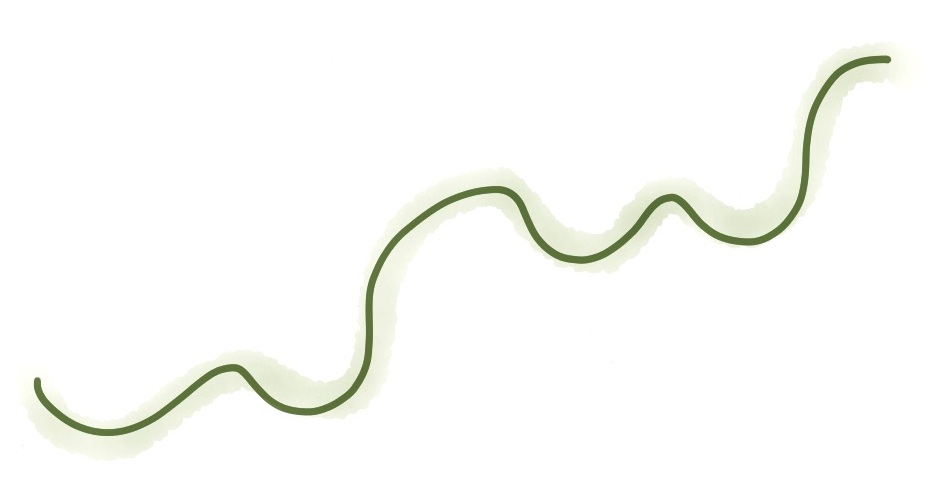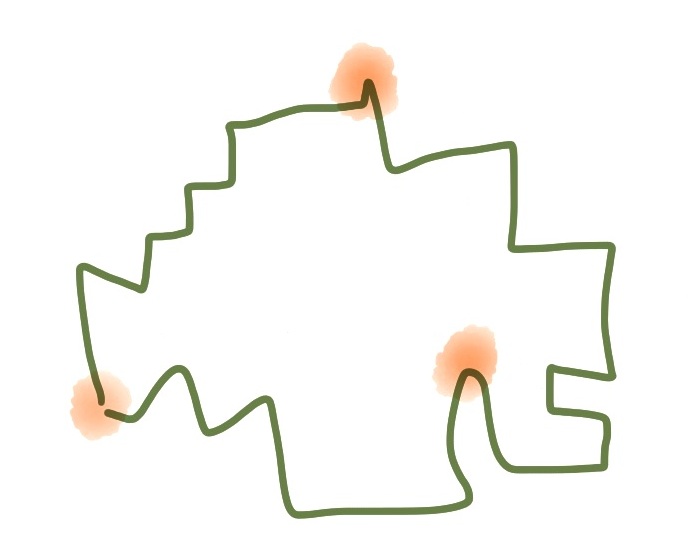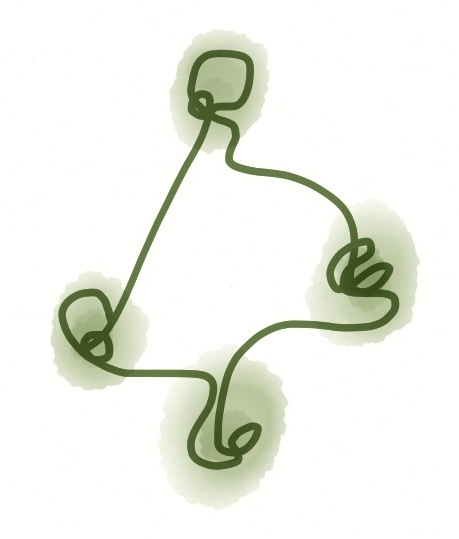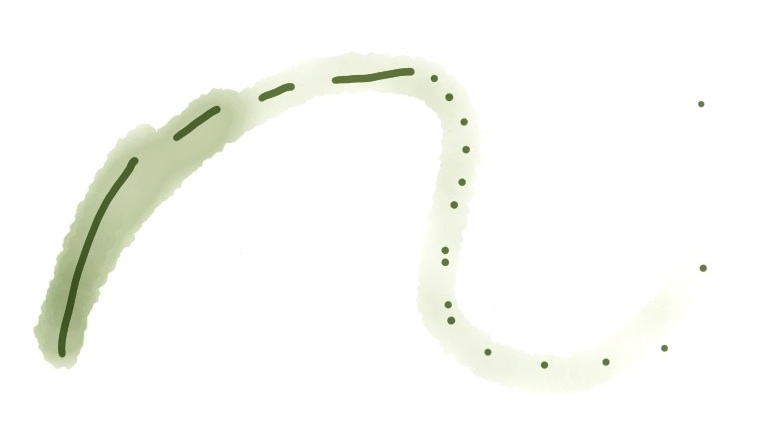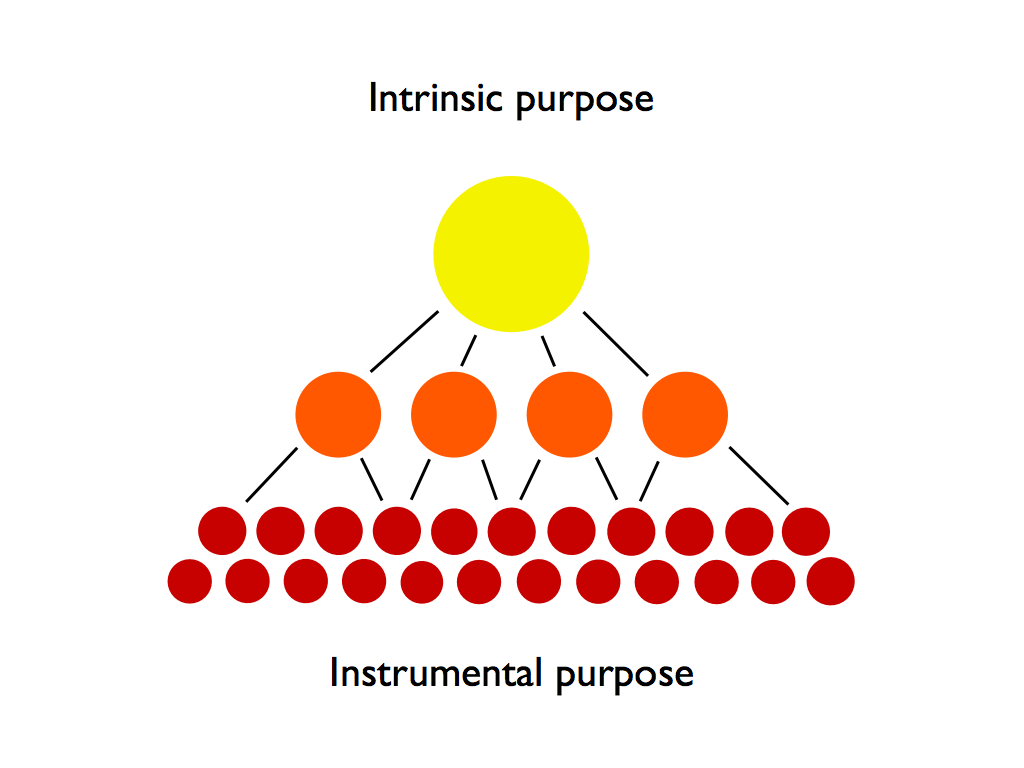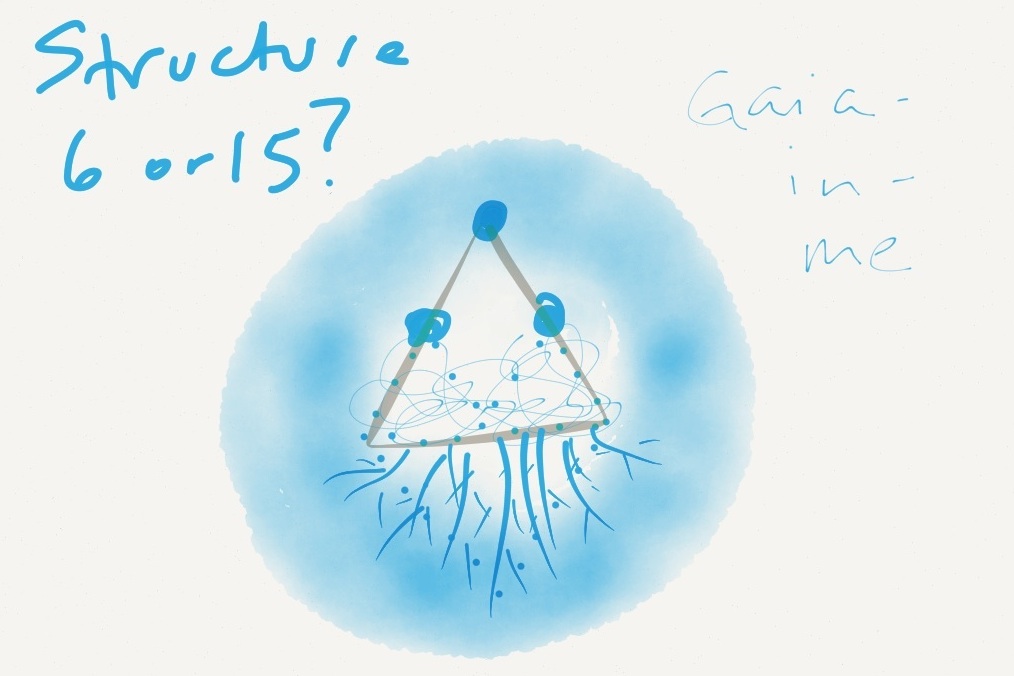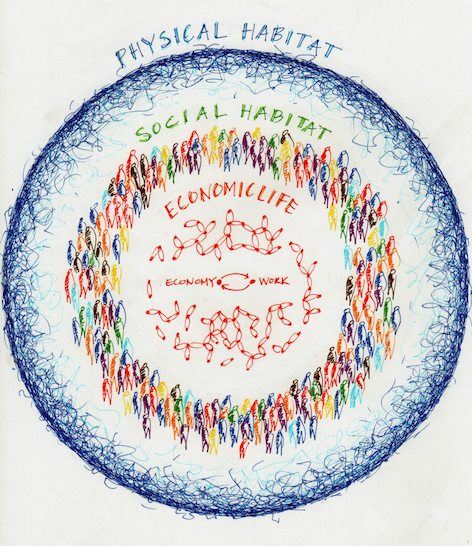I am a 45 year old experiencing nourishing and harmful experiences with the baby-boomer generation ahead of me. I see two extremes of behaviour in this generation about to turn 70: stepping into elderhood and nurture those that follow, or stepping into fighthood and flail about, harming those around them, including themselves. Continue reading Elderhood vs fighthood
Tag: Social Habitat
The gifts of generations
The gifts of generations
Who put honey in your heart of fruition? in your belief in your soul? in your fantasy?in the love in your living room? in the trust in your own perseverance? in your steadfast transformation? in your calling?
A shifting course
A shifting course A hersterical shifting course lives in us profoundly donating self to the sponge of self and other here for me and you to receive without words mystical moments that bless us with lifted veils I am held thank you for a home for my candle of sacred grace burning, singing a delicious legacy of source energy that trusts in me and how I sit in _____ A poem caught in the moving check out of The Circle Way Practicum I co-taught last week with Katharine Weinmann, Ann Linnea and Christina Baldwin. October 4, 2015, Strawberry Creek Lodge, Alberta. _____
What is the meta for?
To get where we want to go, a clear purpose – our sense of direction – is everything. If we don’t know where we are going, and why were are going there, anywhere will do.
Let’s use the metaphor of a city bike tour. The organizers have come together because they know they want to offer something. Their overall purpose is to offer an experience that allows citizens to see their city in a new way, to feel more connected to the city. They imagine that after the bike tour, the impact on citizens is inspiration to find new ways to participate in their city, to simply enjoy it and work to improve it. To pull off a good event, the organizers then need to dig deeper, more specifically, into the purposes of the bike tour, and the purposes of the events that will happen along the way. They have a few options.
They could explore the bike trails along the river the city:
They could visit the best three diners in the city:
They could visit the top four parks:
They could simply head out, unsure of what they would do:
There is nothing wrong with any of the above options; they all meet the overall, ‘intrinsic’ purpose of going on a bike tour to see the city in new ways. There is another layer of purposes that needs to be held: the instrumental purposes of each stop along the way. Once they are known, they will start a dance with the overall purpose and they inform each other. For Steve McIntosh, intrinsic and instrumental purposes are the nature of evolutionary progress. This dynamic takes place even when designing a bike tour of the city.
Knowing what the purpose of each stop along the way is instrumental. If unknown, we lose the overall purpose.
Designing a process without purpose in mind – whether the overall or instrumental purposes of the stops along the way – is not design. It is exploration. Both of these are valuable activities – when aligned with purpose. Sometimes exploration is the purpose…
A clear invitation needs clear purposes.
When the organizers of the bike tour have a clear purposes, they will be able to craft a clear invitation to put out into the world; people to have a clear choice of what kind of bike tour to sign up for. The next layer of purposes are needed – the overall purpose is not enough. For example, for the river valley trail tour, there could be radically different offerings that meet the overall purpose:
- Ride the trails of your city river with friends and family. You will have all the support you need along the way, from washrooms, snacks and technical support. Ride the whole thing, or part. The choice is up to you. See the city from a new angle!
- Learn about the wild in our city. On our bikes, we will take a day to ride the length of city trails with stops along the way to learn about geologic and natural features of our land from local experts. Lunch and bikes provided.
- Explore the wilderness in our city. Bring your journal and your geocaching skills to explore, and navigate, your self and your city. Bring your own lunch and be prepared to look after your own technological troubles. Washrooms will be provided.
The instrumental purposes of each of these invitations are very different. The first is about providing an opportunity for families to explore the river trail system in a relaxed and supportive way. The second event is about offering a traditional learning environment in the natural habitat, learning specific things about nature in the city from experts. The third is a way for individuals to spend time alone in the valley, learning both about themselves and nature. The instrumental purposes shape the overall purpose.
Each of these invitations has a different vibe to which people respond. Knowing the purposes mean we know what we are inviting.
Why the metaphor?
While designing social social habitats, I find it useful to try metaphors on for size, to tease out purposes. I used the metaphor of a city bike tour to figure out what I had to say about purposes here. (I had an email this morning about organizing a bike tour this am!) It helped me reach for the ‘meta’, high level information I was looking for to inform a discussion in a hosting team I am part of, about the need for purpose to be articulated sooner than later.
Metaphor is a great way to explore and define purpose. And once purpose is known, metaphor is an effective way to test if the design is aligned with purpose, a good way to look sideways at our work. Is the purpose of the bike tour more like a fun run, a traditional classroom, or a personal wilderness learning journey?
A note on designing with purpose vs exploring for purpose.
If we start organizing a bike tour by laying out the routes and sites and people we want to use out before us, and start putting them together in ways that make sense to us, we are exploring. We are figuring out what needs to be figured out and in this journey we may find the purpose of the design, but the purpose comes at the end. What have designed only if what we craft reflects the purpose that came at the end.
There is a big trap in designing social processes: while exploring we may think we are designing and miss knowing purpose, or neglect to test our work against the purpose. If we gather a series of tools and methodologies that feel good together and assemble them into a process, we miss the mark because we have not connected to the purpose of the gathering, and the purposes of each part of the gathering. We can even fall into the trap of naming outcomes that will come from the process and feel good about those. It may look good, and feel good – and be false.
Design takes place when purpose is in mind; activities are chosen because they meet the purpose.
WARNING: Purpose can be hard to find.
It is tough slogging to find purpose, as though ‘purpose’ is purposely making itself hard to find. That’s because it’s important.
One of the reasons we fall into the trap of thinking we are designing when we are not is because it is easy and familiar. It is easy to pull out the familiar ideas, or the things we are dying to try, lay out all the ideas and put them to work in ways that feel good. And if after our time exploring we nail down the overall purpose of the event, the smaller purposes are then hard to pin down. It seems to never end, but the pursuit of purpose is necessary for the ultimate design to serve well.
I offer this meta view of purpose as a window into intentional design.
What are you inviting?
The invitation you send out into the world matters – it says everything.
An invitation is both the physical (or digital) thing you send out into the world for an event, and it is also the vibe you send out ahead of it, with it, and afterwards. It is physical and non-physical. Two clients last week exemplify this.
First, a city planner colleague responsible to write a new affordable housing policy for his employer, a municipal government, knows that he doesn’t know everything he needs to know to do this. He wants to check in with a range of people to discern the municipality’s role – in today’s context. He knows he needs to know more. He’s actively inviting a range of voices to influence what he will write.
Second, a school division initiating gay straight alliance groups in its schools has reached a subtle but big understanding – there are lesbian, gay, bisexual and transgendered adults in schools that need care and attention. They have realized that for schools to show up well for kids, the adults also need love, generosity and support. This is the conversation they are stepping into.
What is significant about these folks is the clarity with which they are inviting others to join them in conversations about their work – whether about housing or teaching. Long before an invitation to gather is extended, they are taking the time to get clear about why they need to gather, and deepening into the purpose of each gathering they will call. This is information they will share with the people they gather, and each time we gather, we will spend our time to serve the need and purpose articulated.
As you ponder any invitations you send out into the world, here is a virtuous circle I keep in mind:
- When full of love, I invite compassion
- When full of compassion I invite trust
- When full of trust, I invite brilliance
- When full of brilliance, I invite clarity
- When full of clarity, I invite vision
- When full of vision, I invite passion
- When full of passion, I invite love
Do it all, all at once
Do it all, all at once, as appropriate.
That is what is necessary to engage a whole system.
Otto Scharmer and Katrin Kaufer, in their work Leading from the Emerging Future, describe four levels of social structures that have emerged as humanity grows and develops. The first three are very familiar to us: (1) where power is centralized at the top, (2) where power is decentralized at the top, and (3) where power becomes relational and networked.
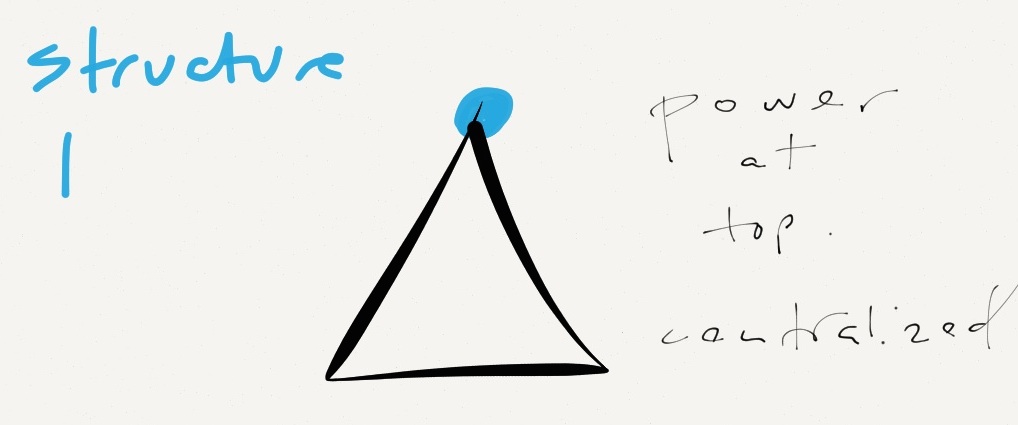
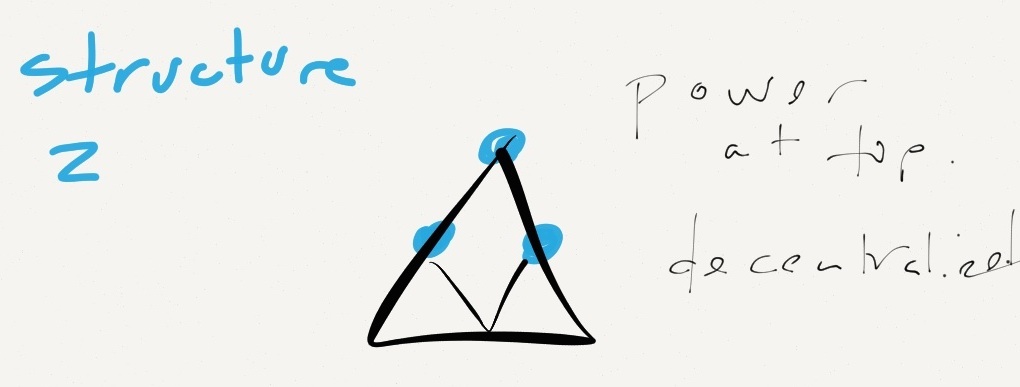
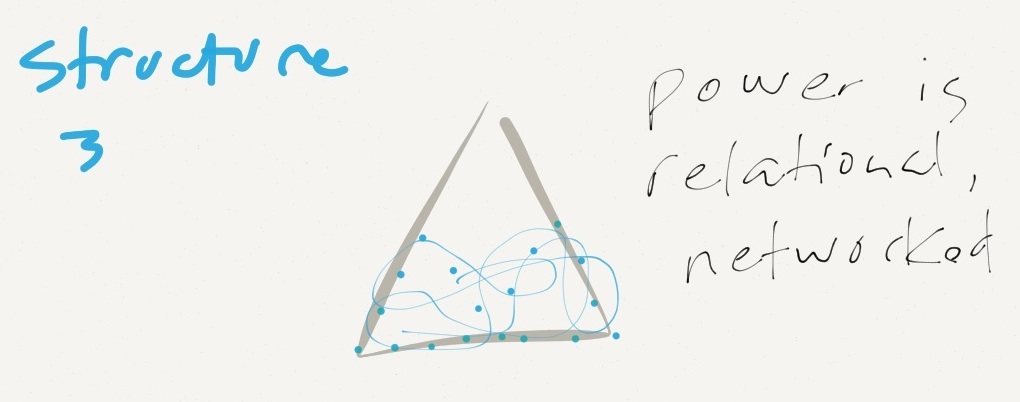
(For readers familiar with the Spiral of values I have previously explored (here’s a primer), Scharmer and Kaufer’s first structure is RED/BLUE, the second BLUE/ORANGE, and the third ORANGE. The fourth, below, is GREEN, with a hint of YELLOW.)
According Scharmer and Kaufer, the fourth structure we are growing into locates power in the social field. They see this clearly, and they see how to create habitats that will allow us to access new knowledge and intelligence that is not accessible with the previous structures.
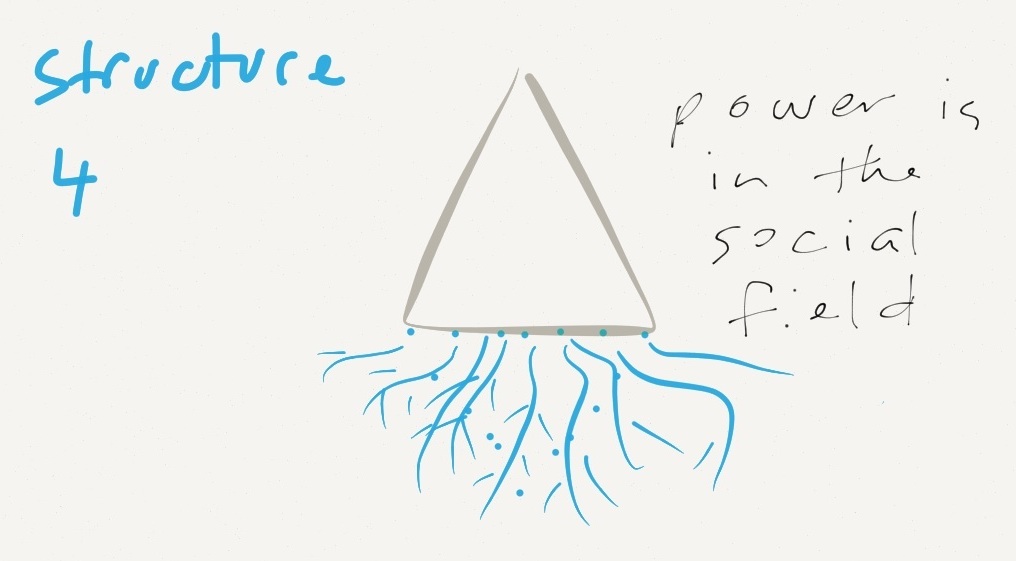
_____
As the structures have evolved, our levels of listening evolve, along with transformations in our levels of awareness and how we coordinate ourselves. It is a journey that is facilitated by infrastructures to help us tap into our creativity, infrastructures to co-initiate, co-sense, co-inspire, to prototype and co-evolve.
The journey they articulate is one where the locus of leadership shifts from ego (me-in-we) to eco (we-in-me). They name the journey we are making from self to Self, from me to we. The most important thing they name are the characteristics of habitats that support and sustain learning. The places we make and shape to nourish and foster the transformation under way matter.
Scharmer and Kaufer stop short of saying something important: all structures have value.
And this leads me to a fifth structure of my own that reflects a leap past the first four to a structure that expects and accepts all structures that Scharmer and Kaufer have identified. We have evolved from structure to structure as they have described. They note that each earlier structure exists in the structures that follow, they leave the reader with a sense that as we advance, we leave the earlier structures behind; they are somehow lesser, no longer appropriate. Their work is incomplete.
My fifth structure, drawing on Spiral Dynamics, is a big leap past structures 1 to 4, because 1+2+3+4=10. It looks like this.
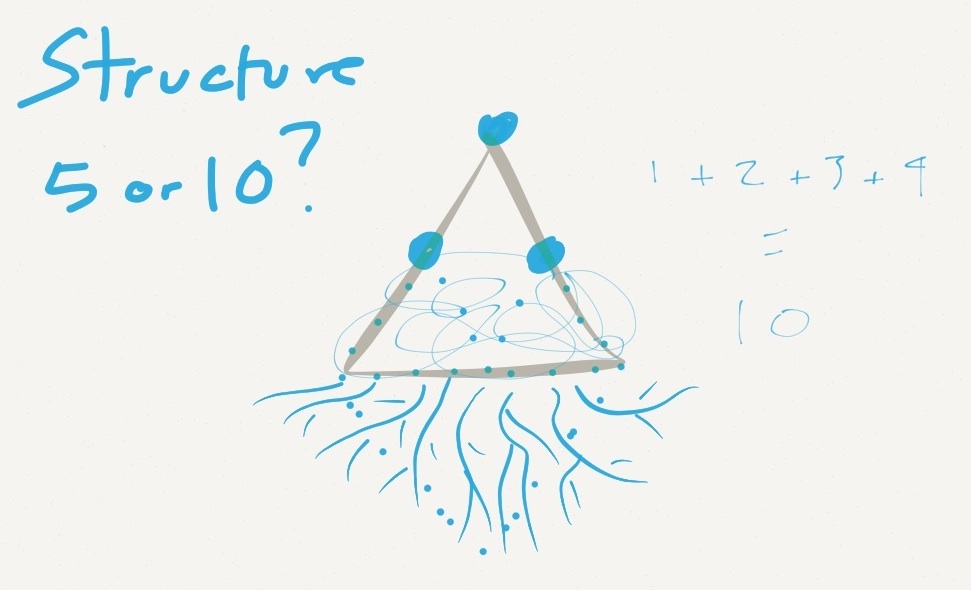
This fifth structure is characterized by a flex and flow of all four of Scharmer and Kaufer’s structures (in Spiral-speak, this is YELLOW). As conditions dictate, all the earlier structures are appropriate. When there is an emergency and fire-fighters are called to action, structure 1 is perfect. When there is no emergency, structure 2 may be appropriate. The fire chief and his personnel retain their hierarchical expectations and organize themselves to make sure the resources are in place for the next emergency; their power is decentralized. Even further behind the scenes, fire department personnel (can) work collaboratively in a network of city builders to make sure that the design of new neighbourhoods meets the needs of citizens and various other needs that need to be met in our city habitats. Their “turf” gets mixed in with that of many other stakeholders in structure 3.
Structure 4 is appropriate when the context allows the players to sit back and contemplate what they are doing and why. It might be a strategic planning session at the fire hall that involves a diverse range of expertise and experience to make wise choices. From structure 5, we see that the time and place varies for each approach, that they all happen, naturally. Where Scharmer and Kaufer characterize structure 4 as eco-in-me, I characterize structure 5 as all-in-me.
Drawing again on Spiral Dynamics, I sense a sixth structure (TURQUOISE), yet again more complex, that encompasses the expanse of systems of systems at work in life. This structure again builds upon the previous structures, taking into account the field in which all systems work, at every scale.
_____
There is a pattern at work in these social structures and within us. What has our attention is expanding. How we organize ourselves is transforming. Here is a summary of these structures. The first 4 belong to Scharmer and Kaufer, the remaining two mine, drawing on the lineage of Spiral Dynamics:
- State-centric – hierarchy and control – traditional awareness
- Free market – markets and competition – ego-system awareness (ego-in-me)
- Social market – networks and negotiation – stakeholder awareness (we-in-me)
- Co-creative – seeing and acting from the whole – eco-system awareness (eco-in-me)
- Co-generative – embodiment of the whole – flexibility/spontaneity awareness (all-in-me)
- Holonic experience of being – expansive planetary connections – global cosmic awareness (Gaia-in-me)
To engage the systems in which we live and work, it is not sufficient to engage only the most recent structure. They all need attention because they all need to be healthy and they all have valuable contributions to make to the system as a whole. We must do it all, all at once, as conditions require. They are all necessary, in the right time and place.
What social structure are you growing into?
______ ______ ______
Need to know a bit more about how all this works? Here are 7 principles that frame the emerging spiral, and 6 conditions for evolutionary expansion.
Some friends and I started a book club to explore Leading from the Emerging Future, Otto Scharmer (Theory U) and Katrin Kaufer’s new book. This is another piece, on Chapter 8. Here’s what came from my exploration of earlier chapters:
- Chapter 1 – Life guard
- Chapter 2 – The antennae of possibility
- Chapter 3 – Prototype social habitats
- Chapter 4 – I’m not a salesperson
- Chapter 5 – Be a vehicle of the future
- Chapter 5 – Offer your Self to your City
- Chapter 6 – Infrastructure for precious communication
- Chapter 7 – Shift the locus of leadership
- Chapter 8 – Meeting vs. learning
_____ _____ _____
Cultivate collective ingenuity
A new form of leadership is emerging that cultivates collective ingenuity at any scale (self, family, neighbourhood, organization, city, nation, humanity) by creating social habitats in which we figure out how to serve ourselves well, so we can serve our cities well. When we serve our cities well, they serve us well in return: a mobuis relationship.
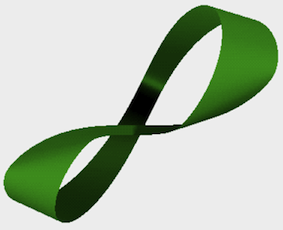
The creation of social habitats that allow citizens and cities to thrive is critical prototype work today that requires people to step into leadership roles to create new kinds of enabling places and spaces that “help people co-sense, co-develop, and co-create their entrepreneurial capacities by serving the real needs in their communities (Scharmer and Kaufer, Leading from the Emerging Future, p. 87).”
The leadership is about people initiating the creation of these places and spaces, but also the co-leadership of people to co-initiate, to jump in on the learning journey. This isn’t leadership work for one leader out front, but for that one leader and all the other leaders who choose to join in. The work to create social habitats that allow us to expand our awareness and consciousness belongs to all of us. It requires all of us to be subject not to change, but to changing.
With my colleagues in the Art of Hosting community (in Edmonton Nov 12-15, 2013), we shift how we meet with each other to create the conditions to co-sense, co-develop and co-create social habitats for changing, social habitats that cultivate collective ingenuity as we have never experienced before.
Here is why this work is important:
Depending on the state of consciousness of a social field or the quality of people’s awareness, social systems enact completely different structures and behaviours. Just like water in the physical system, the makeup of people in a social systems stays the same under a given set of conditions. The difference between natural laws and the social field is that the actors in social systems are able to initiate change. In other words, they are sitting in the water while the temperature changes – and they potentially can get their hands on the temperature control. When their field state of awareness or conversation changes, the actors relate to one another in different ways, and end up creating very different results (Scharmer and Kaufer, p. 69).
Humanity is learning how to consciously notice the temperature changes and how to put our hands on the control. We are learning how to create social habitats in which this can be done as an effective collective – no easy task.
The emerging social habitat is more easily felt, than articulated. We can sense its direction now, but not its destination. It is full of diverse knowledge and opinions. It is full of positions that are cross-purposes. It is full of conflict and uncertainty. It is also full of intention to integrate this massive diversity in an effort to fully see what we collectively know. It is a form of flat, distributed leadership that co-exists with hierarchy when needed. It seeks to meet the needs of many, and trusts that the work we each do is meaningful.
That is what I sense.
What is the emerging social habitat you sense?
*
_____ _____ _____
If the notion of social habitat intrigues you, you might be interested in The Art of Hosting BIG Decisions – While Looking After Self, Other and Place, November 12-15, 2013 in Edmonton.
_____ _____ _____
While working on my book, Nest City: The Human Drive to Thrive in Cities, I am sharing some of my thoughts along the way. Here are some plot helpers to help you navigate the posts:
- My decision to share the book while I am working on it
- The overall structure of Nest City’s three parts
- A summary of Part 1 – City Patterns, Concluding City Patterns
- A summary of Part 2 – Organizing for Emergence, Focus, learn and Emerge
- The plot for Part 3 – City Nestworks
_____ _____ _____
Prototype social habitats
As I prepare to host friends new and old at the November 12-15, 2013 Art of Hosting BIG Decisions gathering, I have engaged in a learning experience with my co-hosts, and a few others, to explore Otto Scharmer and Katrin Kaufer’s new book, Leading from the Emerging Future. As we meet each week, chapter by chapter, new learnings emerge for me as we explore this work individually and collectively.
Scharmer and Kaufer outline the evolution of economic thought and our economy as the evolution of human consciousness. They see a meta-journey of communal then state-centric paradigms, then a free-market paradigm followed by stakeholder or social-market thought. They sense the we may be evolving into an intentional eco-system economy that creates well-being for all. As they take us through 8 acupuncture points that explore how to effect deep systemic change (at the bottom of this post), they remind me that:
- Our economic life – an essential part of our evolutionary journey – is connected to our view of nature.
- Our work, and our passion for our work, is how we connect to economic life.
- Our creativity, individual and collective, is the source of value creation in our economic life.
- Our shared intention, as individual players connected to a larger whole, serves as strategic direction.
- Our awareness, of self and whole, allows us to see where we would like to go, and if we are aiming – and moving – in that direction.
Moreover, Scharmer and Kaufer remind me that the Art of Hosting is an invitation to co-create the the world that wants to be. Our time together in November is an opportunity for us to practice “being and doing” the social habitat we long for, where we gather diverse constellations of people to connect with each other to, as Scharmer puts it, co-initiate, co-sense, co-inspire, co-create and co-evolve.
An Art of Hosting gathering is a safe place to invent and prototype social habitats to power and sustain our well-being, and our evolution.
Will you join us in our work to co-create new social habitats here in Edmonton, in just over a month? November 12-15, 2013
***** *****
Here are Scharmer and Kaufer’s 8 acupuncture points:
- Nature – How can we rethink the economy and nature from “take, make, and throw away” to an integrated closed-loop design, in which everything that we take from the earth is returned at the same or a higher level quality?
- Labour – How can we relink work – the profession we choose to pursue – with Work – what we really love doing?
- Capital – How can we relink the financial economy and the real economy by recycling financial capital into the service and cultivation of ecological, social, and cultural commons?
- Technology – How can we create broad access to the core technologies of the third industrial revolution, blending information technology, regenerative energy, and social technologies in order to unleash individual and collective creativity?
- Leadership – How can we build a collective leadership capacity to innovate at the scale of the whole system?
- Consumption – How can we rebalance the economic playing filed so that consumers can engage in collaborative conscious consumption and become equal partners in an economy that creates well=being for all?
- Coordination – How can we end the war of the parts against the whole by shifting the mode of consciousness from ego-system to eco-system awareness?
- Ownership – What innovations in property rights would give voice to future generations and facilitate the best societal uses of scarce resources and commons?
Some friends and I have started a book club to explore Leading from the Emerging Future, Otto Scharmer (Theory U) and Katrin Kaufer’s new book, chapter by chapter. This is the meaning I made of Chapter 3. Here’s what came of our circle when we met to explore Chapter 1 (Life guard) and Chapter 2 (The antennae of possibility).
Ride the release safely

I knew three years ago that a transition was coming for me in April/May 2013. In 2010 I was elected my my professional planner colleagues to serve one year as president-elect, then two as president, for my professional organization – the Alberta Professional Planners Institute. Our AGM was last week and I have officially handed the reins over to our next president. And I have picked up a new set of reins; as past president, I am on the board of the Canadian Institute of Planners for two years. Knowing this transition was coming, I stepped down as president of my community league.
The nature of the transition is clear and unclear. I have shed my two “presidential” roles and took on a new board. The other transitions I am less clear on. Two significant pieces of contract work are concluding and I don’t know what will come next to help pay the bills. As I look at my schedule for the coming weeks, I see that I have created space for myself to make a transition of some kind. My antennae are work!
Last week, I spent a day with David Whyte, reflecting on my work and where it is going. A big realization came to me: Lost? Let the city find you. On my way to spend a day with a group of women exploring their personal leadership, from the inside to the outside, the ice flows in the river have firmly caught my attention. Just when I think spring’s work is done, when life is flowing freely, a jam I never knew was there releases. I don’t see the jam, just the ice and the debris it carries. The smooth surface of the river’s spring flow is now a torrent, a rush I only noticed with the ice. There’s some inner work to notice what is flowing in and through me, and how to ride the release safely, or how to boldly grow the self.
Today, I have gathered with 40 other circle practitioners to explore our work creating the social containers our world needs at this time. For me, the social habitat is a critical aspect of making cities that serve citizens – and citizens that serve cities. While the gathering is work related, it is equally about my personal social habitat and my approach to myself and my work. My operating principle remains the same: nourish self, others and place.
I have no idea what will come next, but I choose to spend time where I feel nourished, where I can nourish others and the places we live, work and play. I choose to nourish my/our social, physical habitats and my/our economic life. This is ultimately what will enable me to ride the river, and whatever she throws at me.
What ideas and practices support you in your life’s journey?
_____ _____ _____
This post is part of Chapter 8 – The City Making Exchange. Here are some plot helpers of Nest City: The Human Drive to Thrive in Cities, the book I am sharing here while I search for a publisher:
- My decision to share the book while I am working on it
- The overall structure of Nest City’s three parts
- A summary of Part 1 – City Patterns, Concluding City Patterns
- A summary of Part 2 – Organizing for Emergence, Focus, learn and Emerge
- The plot for Part 3 – City Nestworks
_____ _____ _____
Social habitat key to journey
I started this chapter with a reminder that cities are meant to feel uneasy. And living in cities, and the process of creating and recreating them, is a journey in two senses: as we travel along in our evolution and as an act of learning.
The learning that takes place in our cities is a result of our drive to endlessly think, make and do new things to improve the quality of our lives. The work we do creates our cities. But getting improvement means we need to scratch the itch, for the itch is what tells us that there is something to improve. It bothers us, compelling us to do something about it.
We are itching for improvement. At any scale (self, family, neighbourhood, organization, city, region, nation, planet), we experience akrasia, the gulf between what we know we ought to do and what we actually do. This tension serves as the evolutionary driver of cities and our own development.
Our response to our habitat (our surroundings) is what drives the creation of new work, and the development of new work is a survival skill. But this only takes place if and when we are receptive to receiving feedback from our surroundings. Our ability to seek feedback and receive it is a survival skill – at any scale. This practice is critical for our cities, for they are habitats we create for express purpose of improving life. We shape our cities and they, in turn, shape us.
Our ability to evolve our cities is a survival skill. Understanding that our cities, and all their inhabitants, are on a journey together is crucial. We do not know exactly where we are going and we never will. What we do know is that we are going on this trip together. Ensuring a healthy connection between our work and our habitat is crucial, and this connection is dependent upon the social habitat we create for ourselves, for it is our social habitat that invites and allows feedback to flow. If our social habitat is not well, our actions are ill-informed and possibly harmful. If healthy, we are wise. For our cities to be well, we need to create a social habitat where feedback flows.
It is time to embark explicitly on a journey together where we create a social habitat that brings the best out of us, that support each of us, and the collective, in the discomfort we find when we start to scratch the things that itch. We need to organize ourselves to physically build cities that work for us, AND we need to organize ourselves to support each other in the uneasiness of city building.
This is tough work, and critical work. And it will never end because we are forever recreating our world in city, creating new life conditions to which we adapt, creating new life conditions to which we adapt, creating new life conditions to which we adapt etc.
Tomorrow, on Wednesday October 24, 2012, I am spending the day with 18ish to 30ish year-olds in Edmonton to declare the impossibly awesome neighbourhood possible. For this event, I am working with The Natural Step Canada to create a social habitat in which dreams come true. I’ll let you know how it goes.
_____ _____ _____
This post forms part of Chapter 4 – An Uneasy Journey, of Nest City: The Human Drive to Thrive in Cities.
Nest City is organized into three parts, each with a collection of chapters. Click here for an overview of the three parts of Nest City. Click here for an overview of Part 2 – Organizing for Emergence, chapters 4-7.
